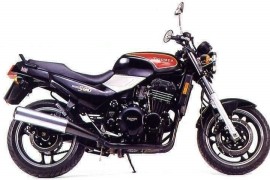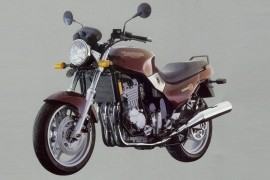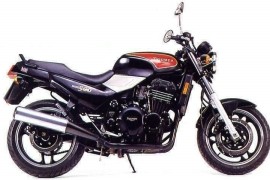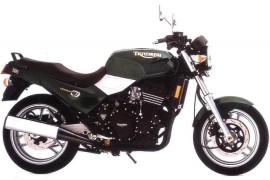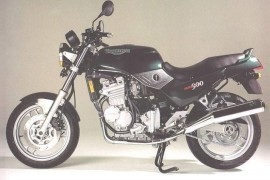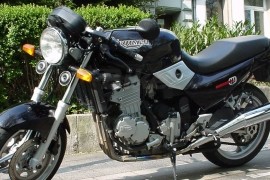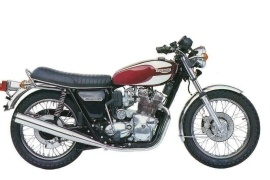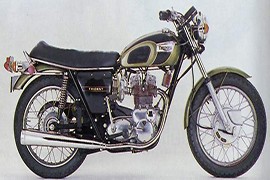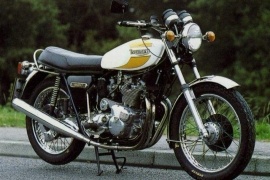TRIUMPH Trident Models/Series Timeline, Specifications & Photos
First production year: 1968
The Triumph Trident was a standard naked motorcycle powered by a 750 or 900cc three-cylinder manufactured by Triumph Motorcycles Ltd from 1991 to 1998 at the Hinckley factory in Leicestershire, England.
The Triumph Trident range comprised two 750 and 900cc three-cylinder motorcycles and two 1,000 and 1,200cc four-cylinder models. The models were shown for the first time at the 1990 Cologne Motorcycle Show and had famous names from the glory days of Meriden Triumph.
In 1993, the British motorcycle manufacturer launched the Triumph Trident 900, a naked motorcycle in its third year of production. The 1993 machine came with the same specifications as previous models without any modifications.
In the visual department, the bike packed standard features, such as a large round headlight with the instrument cluster mounted on top, a one-piece dual seat with a passenger grab rail, a dual exhaust system with a muffler on each side, and three double-spoke aluminum wheels.
In the performance department, the 1993 Triumph Trident 900 had its soul brought to life by an 885cc four-stroke three-cylinder liquid-cooled engine fed by three Mikuni carburetors, delivering 99 hp at 9,000 rpm and 83 Nm (61 lb-ft) torque at 6,500 rpm.
The power produced by the engine was handled by a six-speed manual transmission with a cable-operated clutch and a final chain drive, pushing the motorcycle to 215 kph (133 mph).
The Triumph Trident was a standard naked motorcycle manufactured by Triumph Motorcycles Ltd from 1991 to 1998. The bike was powered by a 750 or 900cc engine and was made at the Hinckley factory in Leicestershire, England.
In 1990, at the Cologne Motorcycle Show, Triumph presented a range of 750 and 900cc three-cylinder machines alongside 1,000 and 1,200cc four-cylinder models. The bikes used famous names from the glory days of Meriden Triumph.
In 1993, the British motorcycle manufacturer launched the Triumph Trident 750, the smallest displacement machine in the range, packing the same technical, aesthetic, and performance specifications as the previous model without any modifications.
In the visual department, the 1993 model packed the same standard features as the previous model, such as a round headlight, a one-piece dual seat with a passenger grab handle, a dual exhaust system with a muffler on each side, and lightweight aluminum wheels.
In the performance department, the 1993 Triumph Trident had its soul brought to life by a 749cc four-stroke liquid-cooled three-cylinder engine with three carburetors in charge of feeding the pistons, delivering 97 hp at 8,750 rpm and 66 Nm (49 lb-ft) torque at 8,500 rpm.
The bike's power was handled by a six-speed manual transmission with a cable-operated clutch and a final chain drive, spinning the rear wheel to a top speed of 215 kph (133 mph).
First released in 1991, the Triumph Trident was a standard motorcycle with a 750 or 900cc three-cylinder engine manufactured until 1998 at the Hinckley factory in Leicestershire, England.
In 1992, the British motorcycle manufacturer launched the Triumph Trident 900, a naked motorcycle that packed the same technical, visual, and performance specifications as the previous model without any significant modifications.
In the visual department, the bike was similar to its predecessor, packing standard features, such as a large round headlight with the instrument panel mounted on top, a one-piece dual seat with a pillion grab rail, a dual exhaust system with a muffler on each side, a side stand, and three double-spoke aluminum wheels.
The bike's suspension comprised a 43 mm telescopic fork on the front and a tri-link adjustable shock absorber on the rear, delivering optimum suspension performance and handling capabilities.
As for the braking power, the bike's wheels were fitted with two 296 mm discs tied to dual-piston calipers on the front and a 255 mm disc with a dual-piston caliper on the rear, offering optimum stopping power.
In the performance department, the 1992 Triumph Trident 900 had installed underneath its fuel tank an 885cc four-stroke three-cylinder liquid-cooled engine fed by three Mikuni carburetors, boasting 99 hp at 9,000 rpm and 83 Nm (61 lb-ft) torque at 6,500 rpm.
The Triumph Trident was a standard motorcycle powered by a three-cylinder that came in two configurations, 750 and 900cc. Both machines were produced from 1991 to 1998 at the Hinckley factory in Leicestershire, England.
In September 1990, at the Cologne Motorcycle Show, a range of three-cylinder motorcycles with 750 and 900cc but also 1,000 and 1,200cc were presented and were designated with famous names from the glory of Meriden Triumph. The bikes were presented to the public between March and September 1991.
In the visual department, the bike was equipped with standard features, such as a large round headlight with an instrument panel on top, a one-piece dual seat with a passenger grab rail, a dual exhaust system with a silencer on each side, and three double-spoke aluminum wheels.
In the suspension department, the bike packed a 43 mm non-adjustable telescopic fork on the front and an adjustable gas-charged shock absorber on the rear, delivering optimum handling capabilities.
The braking power was handled by two 296 mm discs squeezed by dual-piston calipers on the front wheel and a 255 mm disc with a dual-piston caliper on the rear wheel, offering optimum stopping power.
As for the power figures, the 1992 Triumph Trident 750 had its soul brought to life by a 749cc four-stroke three-cylinder liquid-cooled engine that delivered an output power of 97 hp at 8,750 rpm and 66 Nm (49 lb-ft) torque at 8,500 rpm.
The Triumph Trident was a standard naked machine powered by a three-cylinder 750 or 900cc engine. The bikes were manufactured from 1991 to 1998 at the Hinckley factory in Leicestershire, England.
In 1991, the British motorcycle manufacturer launched the Triumph Trident 900, a naked motorcycle in the same shape and form as the smaller 750cc version but with a slightly larger engine that delivered more power and torque.
Both machines shared the same standard features, such as a large round headlight with the instrument panel mounted on top, a one-piece dual seat with a passenger grab rail, a dual exhaust system with a silencer on each side, and three-spoke lightweight aluminum wheels.
In the suspension department, the bike packed a 43 mm telescopic fork with 150 mm wheel travel on the front and an adjustable shock absorber with 120 mm wheel travel on the rear, offering optimum handling.
In the braking department, the bike's wheels were fitted with two 296 mm discs tied to dual-piston calipers on the front and a 255 mm disc with a dual-piston caliper on the rear, providing optimum stopping power.
As for the power figures, the 1991 Triumph Trident 900 had its soul brought to life by an 885cc four-stroke three-cylinder liquid-cooled engine that delivered an output power of 99 hp at 9,000 rpm and 83 Nm (61 lb-ft) torque at 6,500 rpm.
The Triumph Trident was a standard motorcycle powered by a three-cylinder 750 or 900cc engine. The bike was manufactured from 1991 to 1998 at the Hinckley factory in Leicestershire, England.
In 1991, the British motorcycle manufacturer launched the first Triumph Trident 750, a naked motorcycle that used a modular liquid-cooled DOHC engine design fitted in a steel frame with a large-diameter backbone design.
In the visual department, the bike was fitted with standard features, such as a large round headlight with the instrument cluster mounted on top, a one-piece dual seat with a passenger grab rail, a center stand, and three-spoke lightweight aluminum wheels.
The bike's suspension system comprised a 43 mm non-adjustable telescopic fork on the front and a gas-charged adjustable shock absorber on the rear, delivering optimum suspension performance and handling.
In the braking department, the wheels were fitted with two 296 mm discs squeezed by dual-piston calipers on the front and a 255 mm disc with a dual-piston caliper on the rear, offering optimum stopping power.
In the performance department, the 1991 Triumph Trident 750 had its soul brought to life by a 749cc four-stroke three-cylinder liquid-cooled engine fed by three BST CV carburetors, delivering 97 hp at 8,750 rpm and 66 Nm (49 lb-ft) torque at 8,500 rpm.
A six-speed manual transmission that spun the rear wheel through a final chain drive handled the bike's power.
The Triumph Trident T160was in production for just three years, but its roots lay in the T150 Trident launched in 1968. There are two major differences between the two models. The first is that the T160 was fitted with both kickstart and electric start (the T150 was kickstart only).
The next major change came with the 1973 and 1974 T150V, with addition of a much-needed hydraulic front disk brake and the long-awaited 5-speed gearbox, which is what the "V" stands for in the model designation. Styling was cleaned up also, in keeping with the Bonneville line.
Launched in 1968, the Trident T150 750 was fast, fine handling and arguably the first ever superbike. The Triumph Trident and its blood brother, the Rocket 3, can lay a strong claim to being the first mass-produced superbikes, predating the fatter, slower, Honda 750 Four.
